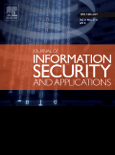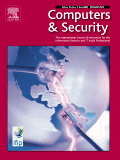
Journal of Information Security and Applications
Scope & Guideline
Navigating Challenges in the Realm of Security
Introduction
Aims and Scopes
- Cryptography and Secure Communication:
Research related to cryptographic algorithms, protocols, and systems designed to secure communication channels. This includes advancements in encryption techniques, digital signatures, and secure messaging. - Privacy and Data Protection:
Studies focused on privacy-preserving techniques, data anonymization, and protection mechanisms that ensure user privacy in various applications, particularly in cloud computing and IoT environments. - Malware Detection and Prevention:
Innovations in detecting and mitigating malware threats, including the use of machine learning, deep learning, and behavioral analysis to identify malicious activities in software and networks. - Access Control and Authentication:
Research on methods and frameworks for secure access control, authentication schemes, and identity management, particularly in decentralized and cloud-based systems. - Intrusion Detection and Response:
Development of systems and methodologies for detecting intrusions and responding to security breaches in real-time, utilizing techniques from artificial intelligence and machine learning. - Blockchain and Distributed Ledger Technologies:
Exploration of blockchain applications, including secure transactions, smart contracts, and the integration of blockchain with other security paradigms for enhanced data integrity and transparency. - Security in Emerging Technologies:
Investigations into security challenges and solutions within emerging technologies such as IoT, 5G networks, and AI, focusing on their unique vulnerabilities and protective measures.
Trending and Emerging
- Homomorphic Encryption and Privacy-Preserving Computation:
There is a growing interest in homomorphic encryption and techniques that allow computations on encrypted data without decrypting it, which is crucial for secure data sharing in cloud environments. - AI and Machine Learning for Security:
The integration of artificial intelligence and machine learning in security applications is trending, with research focusing on automated threat detection, adaptive security measures, and predictive analytics. - Federated Learning and Decentralized Models:
Research on federated learning, which allows for collaborative model training without sharing raw data, is gaining traction, particularly for privacy-sensitive applications in healthcare and finance. - Quantum-Safe Cryptography:
As quantum computing poses a potential threat to classical cryptographic systems, there is an emerging focus on developing quantum-resistant algorithms to ensure long-term security. - Data Integrity and Provenance:
Studies addressing data integrity and provenance management, particularly in blockchain applications, are on the rise, reflecting the need for reliable tracking of data origins and modifications. - Secure IoT Architectures:
Research into secure architectures for IoT devices and networks is expanding, emphasizing the need for robust security measures to protect against the unique vulnerabilities of interconnected devices.
Declining or Waning
- Traditional Network Security:
Research focused on traditional network security measures, such as firewalls and basic intrusion detection systems, is becoming less prevalent as more advanced, adaptive systems are being developed. - Static Malware Analysis:
The emphasis on static analysis techniques for malware detection is waning, as dynamic analysis and behavioral detection methods gain favor due to their effectiveness in dealing with sophisticated malware. - Basic Encryption Techniques:
There is a noticeable decrease in papers discussing basic encryption algorithms, with a shift towards more complex and innovative cryptographic approaches such as homomorphic encryption and quantum-resistant algorithms. - Legacy Systems Security:
Research dedicated to securing legacy systems is diminishing, likely due to the increasing adoption of modern architectures and the associated security practices that address contemporary threats. - Single-Factor Authentication:
The focus on single-factor authentication approaches is declining as multi-factor authentication methods become the standard for enhancing security in various applications.
Similar Journals

Journal of Information Assurance and Security
Advancing Insights for Robust Data Protection.Journal of Information Assurance and Security, an esteemed publication by DYNAMIC PUBLISHERS, INC, serves as a pivotal platform for the dissemination of innovative research and insights in the field of information security and assurance. With its ISSN 1554-1010 and E-ISSN 1554-1029, this journal addresses critical vulnerabilities, emerging technologies, and methodologies that fortify data integrity and uphold privacy in our increasingly digital world. Although specific metrics such as the HIndex and Scopus ranks are currently unavailable, the journal is recognized for its contributions to both academia and industry, fostering collaboration among researchers, professionals, and students dedicated to advancing security protocols. The journal does not currently offer open access but ensures comprehensive accessibility through institutional subscriptions. As cybersecurity continues to be a paramount concern globally, the Journal of Information Assurance and Security stands out as an essential resource for groundbreaking studies and practical applications that drive the future of information protection.

International Journal of Web Services Research
Empowering Knowledge Sharing in Web ServicesThe International Journal of Web Services Research, published by IGI Global, is a premier forum dedicated to advancing research and innovation in the field of web services. With an ISSN of 1545-7362 and an E-ISSN of 1546-5004, this journal has steadily contributed to the discourse on computer networks, information systems, and software development since its inception in 2004. Based in the United States, the journal publishes high-quality research articles that delve into cutting-edge web service technologies and methodologies, making it an invaluable resource for researchers, professionals, and students alike. Although categorized in the Q4 quartile in 2023 across several classifications, its growing impact and relevance are reflected in its ongoing engagement with contemporary issues in the web services landscape. As an academic platform, it aims to provide a comprehensive understanding of the dynamics of web services and their implications for future technological advancements. Researchers are encouraged to contribute their findings to foster knowledge sharing and collaboration within this vital domain.

Journal of Cloud Computing-Advances Systems and Applications
Exploring the Future of Cloud InnovationsThe Journal of Cloud Computing - Advances Systems and Applications, published by Springer, serves as a premier platform for disseminating cutting-edge research in the fields of cloud computing, computer networks, and software technologies. With an impressive impact factor and ranked in the top quartile for Computer Networks and Communications and Software categories in 2023, this open access journal has gained significant recognition within the academic community since its establishment in 2012. The journal not only provides valuable insights into innovative applications and advancements in cloud technologies but also supports collaboration among scholars, practitioners, and industry leaders. Operating from the vibrant hub of New York City, it boasts a robust international readership, ensuring that the latest findings reach a diverse audience. Authors and researchers are encouraged to engage with this vital resource, which is dedicated to exploring the transformative potential of cloud computing across multiple disciplines.

International Arab Journal of Information Technology
Exploring New Frontiers in Information TechnologyWelcome to the International Arab Journal of Information Technology, a prestigious publication under the aegis of ZARKA PRIVATE UNIVERSITY in Jordan, dedicated to advancing the field of Information Technology. First established in 2008, this journal has made significant strides in disseminating high-quality research, achieving an impressive Q2 ranking in Computer Science (miscellaneous) and securing a notable 57th percentile position in the Scopus rankings. With a comprehensive scope encompassing various sub-disciplines of computer science, the journal is committed to promoting scholarly dialogue and innovation among researchers, professionals, and students. While currently operating as a subscription-only journal, it remains a vital resource for the academic community seeking to explore the latest trends and advancements in technology. The International Arab Journal of Information Technology is not only a platform for original research but also a vibrant hub for ideas that shape the technological landscape of the Arab region and beyond.

Journal of Computer Virology and Hacking Techniques
Advancing Knowledge in Computer Virality and Hacking TechniquesWelcome to the Journal of Computer Virology and Hacking Techniques, a prestigious academic publication dedicated to the evolving fields of cybersecurity and digital threats. Published by Springer France, this open-access journal has been at the forefront of disseminating high-quality research since its inception in 2014. With an increasing impact in areas such as computational theory, hardware architecture, and software security, the journal holds a significant position, classified in the Q2 and Q3 quartiles across several categories in 2023. The journal aims to provide a platform for researchers, professionals, and students to explore the latest advances in combatting cyber vulnerabilities and understanding hacking techniques. In alignment with its open-access policy, the journal ensures that knowledge is readily available to a global audience, reinforcing its mission to enhance the scholarly discourse surrounding computer virality while adhering to rigorous academic standards.

International Journal of Electronic Security and Digital Forensics
Fostering collaboration for cutting-edge cybersecurity insights.The International Journal of Electronic Security and Digital Forensics, published by INDERSCIENCE ENTERPRISES LTD, is a leading platform for disseminating scholarly research in the realms of cybersecurity, digital forensics, and electronic security. Established with the objective of bridging the gap between theoretical advancements and practical applications, the journal spans critical areas such as network security, legal implications of digital forensics, and reliability in safety measures. With its ISSN 1751-911X and E-ISSN 1751-9128, the journal aims to provide valuable insights into emerging technologies and methodologies while maintaining high academic standards, as reflected in its diverse quartile rankings across multiple categories in 2023. Operating from the United Kingdom and catering to a global audience, the journal is committed to fostering innovative research that contributes to safer digital environments. Researchers, professionals, and students will find a wealth of information and opportunities for collaboration in this specialized field, making International Journal of Electronic Security and Digital Forensics an essential resource for advancing knowledge and practice.

Internet Technology Letters
Connecting Academia and Industry Through Cutting-edge Research.Internet Technology Letters, published by John Wiley & Sons Ltd, is a dynamic and rapidly evolving journal that focuses on the innovative applications and developments within the realms of Artificial Intelligence, Computer Networks and Communications, Information Systems, and Software. With its E-ISSN 2476-1508 and a defined convergence period from 2018 to 2024, this journal seeks to address emerging trends and critical challenges confronting the digital landscape today. Recognized in the Q3 quartile range across multiple computer science categories in 2023, it serves as a valuable resource for researchers, professionals, and students seeking to advance their knowledge and stay updated on significant technological advancements. While currently not an open-access journal, Internet Technology Letters holds a prominent position on platforms like Scopus, ranked within the middle percentiles, reflecting its contribution to the academic community. The journal aims to foster connectivity between academia and industry, encouraging submissions that promote interdisciplinary collaboration and innovation. By creating a platform for sharing groundbreaking research, Internet Technology Letters plays a crucial role in shaping future technological landscapes.

COMPUTERS & SECURITY
Leading the charge in cutting-edge cybersecurity research.COMPUTERS & SECURITY is a leading international journal published by Elsevier Advanced Technology, dedicated to advancing the interdisciplinary field of cybersecurity. With an impact factor reflecting its prestige, this journal holds a remarkable Q1 ranking in both Computer Science and Law categories according to the 2023 rankings. Since its inception in 1982, it has provided a platform for high-quality research that addresses key challenges in computer security, cyber law, and technology policy, and aims to evolve as the digital landscape continues to transform. Researchers and professionals seeking to contribute to vital discussions about security vulnerabilities, threat mitigation, and legal frameworks will find this journal an invaluable resource. Although it is not open access, the journal maintains a robust presence in the scholarly community, with exceptional rankings in Scopus—#7 in Social Sciences (Law) and #18 in General Computer Science, both highlighting its critical role in shaping knowledge and practice in these fields.

JOURNAL OF CRYPTOLOGY
Pioneering Insights into Encryption and Information SecurityJOURNAL OF CRYPTOLOGY, published by SPRINGER, stands at the forefront of research in the domains of applied mathematics, computer science applications, and software security. With a history of significant contributions since its inception in 1988, this esteemed journal encompasses a broad range of topics in cryptology, including but not limited to encryption, security protocols, and information security systems. Holding a prestigious Q1 classification in multiple fields, it ranks #45 out of 635 in Applied Mathematics and has esteemed positions in Computer Science categories, reflecting its influence and recognition in the academic community, as evidenced by its high percentiles. As a vital resource for researchers, professionals, and students, the JOURNAL OF CRYPTOLOGY not only aims to disseminate innovative findings and methodologies but also fosters an engaging discourse within the cryptology and cybersecurity realms. Notably, it offers access through traditional subscription models, ensuring that readers benefit from a rigorous selection of high-impact research articles. Explore groundbreaking advancements and contribute to the ongoing dialogue in this pivotal field through your engagement with our journal.

ISeCure-ISC International Journal of Information Security
Unveiling Insights in the Evolving Landscape of CybersecurityISeCure-ISC International Journal of Information Security, published by the Iranian Society of Cryptology, is a vital open-access platform dedicated to advancing the field of information security. Since its inception in 2009, the journal has strived to disseminate high-quality, peer-reviewed research that addresses contemporary challenges in information security, cryptography, and related computational disciplines. With an ISSN of 2008-2045 and an E-ISSN of 2008-3076, it has gained visibility in the academic community, evidenced by its Quartile 4 ranking across multiple categories such as Applied Mathematics, Computational Theory, and Information Systems. This journal aims to foster innovative solutions and theoretical advancements, targeting researchers, professionals, and students who seek to contribute to and learn from the latest developments in the field. By providing a venue for explorative and empirical research, ISeCure-ISC holds an important position in promoting knowledge and collaborative efforts within the global information security landscape.